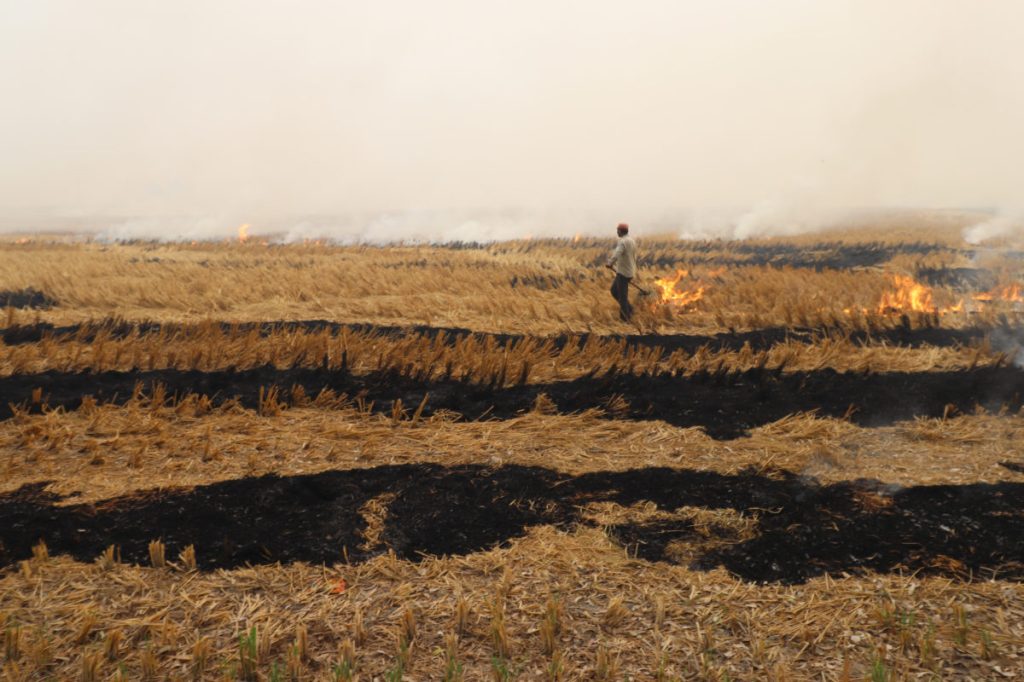Agriculture burning contributes significantly to air pollution in India, a country with some of the least healthy air in the world. While regulations exist to reduce these fires, burning continues, in part due to the belief that profitable alternatives don’t exist. A recent commentary published in the journal Science by researchers from The Nature Conservancy, the International Maize and Wheat Improvement Center, the University of Minnesota and several other partners collects evidence on alternatives to burning, makes a business case for these practices and identifies barriers and remaining uncertainties.
The Gist
Northwest India’s Indo-Gangetic plain is the region’s breadbasket; more than 80 percent of agriculture there focuses on a rice-wheat cropping rotation. Rice is harvested, and soon thereafter wheat is planted. This process has accelerated due to concerns over groundwater levels. Farmers, who plant rice to coincide with monsoon rains, have only 10-20 days to get wheat planted. To accomplish this, they burn their rice fields, resulting in significant air pollution and short-lived climate pollutants. Many among the region’s 2.5 million farmers burn an estimated 23 million tons of rice residue in their fields every year.
Regulations are in place to reduce agricultural fires, but burning continues because of implementation challenges and lack of clarity about the profitability of alternate no-burn farming strategies. Thus, the paper’s authors examined ten existing alternative wheat farming practices in the region, evaluating them for public and private costs and benefits, and potential scalability.
To assess the private benefits, the researchers conducted cost benefit analyses and estimated annual average per hectare net profits from each farming system.
The most profitable farming systems use rice straw as mulch on the fields, eliminating the need for burning. In these systems, a tractor-mounted device called the Happy Seeder is used to plant wheat directly into straw-laden farm plots. When rice is ready to be reaped, a mechanical harvester collects the grain, a spreader distributes the straw that remains on the ground and the Happy Seeder drills into the land to seed the wheat after further shredding and spreading the straw.
The Happy Seeder-based systems are on average 10 percent more profitable than the most profitable burning option and 20 percent more profitable than the most common burn system. Baling of rice straw for use in power plants another alternative, is not as profitable as the Happy Seeder-based systems but offers equivalent profits to burning. Systems where farmers try to eliminate burning by incorporating straw into the ground are the least profitable.
Additionally, all methods that do not include burning carry much lower public costs, due to the reduction or elimination of particulate pollution.
The Big Picture
In November 2017, more than 4,000 schools closed in Delhi due to seasonal smog. This smog increases during October and November when fields are burned. It causes major transportation disruptions and poses health risks across Northern India, including Delhi, a city of more than 18 million people.
The costs of agricultural burning are significant, but adoption of new agricultural technology can be slow. There are numerous barriers to adoption, including upfront costs to farmers, lack of knowledge of new practices and their impacts on profits, limited incentive to change practices given uncertain policies, and insecurity regarding local availability of inputs for alternate farming practices.
Government action and private investment can accelerate the adoption of the Happy Seeder technology and address barriers. Government subsidies for agricultural implements that are currently in place are already increasing the number of Happy Seeders in use.
For full scaling, the paper’s authors identify several important steps including:
- Increased manufacturing and service provision by the private sector.
- Burning ban enforcement, education and financial incentives by the government.
- Communication, social nudging through trusted networks and demonstration and training for farmers by non-governmental organizations and universities.
The Takeaway
Often, there are difficult tradeoffs between environmental improvement and economic opportunity. This is not the case with conservation alternatives to rice field burning in India. The Science analysis demonstrates that it is possible to reduce air pollution and greenhouse gas emissions in a way that is profitable to farmers and scalable. A move towards no-burn agricultural will also help the Government of India’s policy goal of doubling farmers’ incomes in India.
Agricultural fires are an environmental issue in many parts of the world. India has the opportunity to reduce burning, increase incomes and transition to more sustainable agriculture – all while reducing seasonal air pollution. This in turn offers lessons for other countries facing similar challenges and solutions.




Having experienced the Delhi smog of November 2017, I cannot agree more with this article. A few points that need to be considered are:
– The smog got so bad that the Indian Government declared a ban on industrial and constructional activity! Not an economical cost to the farmer but potentially a huge cost to the country of India! It would be interesting to see an estimate to the cost of this?
– The negative effects on health of both Delhi inhabitants as well as the farmers or farm laborers that did the burning. Perhaps a powerful message to teach farmers of the hazards of burning croplands, knowing India though perhaps not as strong as the message of Profit!